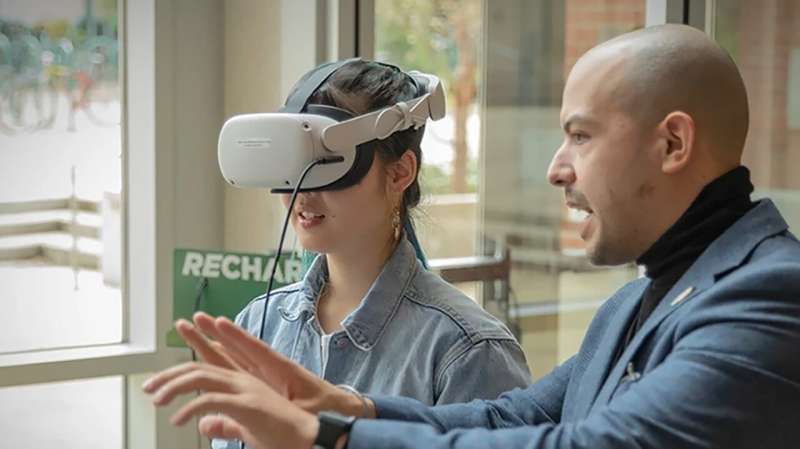Seeing is believing. But according to new virtual reality research from the University of Oregon, observation may not be enough to activate people on environmental issues. Engagement is key.
Compared to traditional video, environmental stories told through metaverse technologies, including virtual reality and 360-degree video, can better motivate people to act on environmental threats.
As described in a paper published Jan. 8 in the journal Cyberpsychology, Behavior, and Social Networking, the metaverse not only provides a fantastical visual experience but an interactive one that can make seemingly distant threats, like climate change or ocean acidification, feel close and personally relevant.
“The magic of VR isn’t just that it transports you somewhere, but it meaningfully uses interactivity to reduce psychological distance and increase immersion,” said Daniel Pimentel, an assistant professor in immersive media psychology at UO’s School of Journalism and Communication.
“That is one of the biggest mechanisms in environmental storytelling that we’re not really focusing on but should be. It’s not merely enough to place people in digital environments; we have to ensure that when they’re there, they can engage with the story.”
Environmental communicators can utilize metaverse technologies to tell interactive stories that help change people’s attitudes and perceptions on environmental issues, said Pimentel, co-director of UO’s Oregon Reality Lab in Portland.
In their latest research, Pimentel and his collaborator, Sriram Kalyanaraman of the University of Florida, conducted a series of studies testing whether storytelling through immersive media could shape people’s threat perceptions and engagement in pro-environmental activities.
They also surveyed people’s positive or negative attitudes toward the message and narrative.
“If you want to change minds and hearts, you need a story that people enjoy, right?” Pimentel said. “You want them to enjoy the storytelling experience, otherwise, it’s not going to resonate with them.”
In their first experiment, the researchers had study participants watch either an interactive, 360-degree video or a 2D equivalent on climate change in Alaska. As revealed in follow-up questionnaires, participants who watched the 360-degree video felt a greater sense of presence and closeness to the depicted threats than those who watched the 2D projection.
“I was probably the most surprised by this result,” Pimentel said, “because VR video alone, without even using a headset, already led to differences in how people conceptualized the information and thought of the threats more concretely and less abstractly.”
Because of VR’s immersive capabilities, the researchers wondered if distant environmental threats could feel closer to home. Similar to the first study, participants watched either a 360-degree video or flat equivalent but on an underwater exploration highlighting coral bleaching.
Some participants watched a video that said the incident took place locally in Florida—all participants were college students in Florida—whereas others were informed it was set distantly in South Africa.
The participants’ perceptions on a local issue didn’t change much whether it was presented in a 360-degree or 2D format. Pimentel suggested it’s difficult to make an already local issue feel closer.
But for a distant threat, the added interactivity heightened participants’ attitudes.
“When it’s a distant story, 360-degree video really matters,” Pimentel said.
To investigate if a VR headset could elevate the experience, the researchers had some participants watch the 360-degree ocean video through a headset instead. Participants with the headset had a more naturalistic way of controlling their point of view, whereas those without had to move by clicking and dragging with a mouse.
Being fully immersed in audio and visual to a degree that a flat screen cannot achieve led these participants to report greater intentions to help the environment, Pimentel said.
“The more you engage with something, the more concrete and relevant it becomes,” he said. “Immersive media helps you perceive things as happening and occurring more presently. This research is a story of three studies that are saying the same thing: Interactivity increases cognitive absorption, which in turn leads to favorable evaluations of a message and how we see threats.”
But not every environmental story needs to be in the metaverse, Pimentel cautions. It needs to be justified, and in this case, it’s expensive to take people on scuba dives to learn about coral bleaching, he said.
“It’s less about using immersive media technologies for the sake of using them and rather thinking holistically, meaningfully and deeply about why you’re using these platforms,” Pimentel said. “What we’re trying to do with our research is understand what levers we can pull as storytellers that lead to particular outcomes.”
More information:
Daniel Pimentel et al, How Cognitive Absorption Influences Responses to Immersive Narratives of Environmental Threats, Cyberpsychology, Behavior, and Social Networking (2024). DOI: 10.1089/cyber.2022.0401
Provided by
University of Oregon
Citation:
Storytelling in the metaverse can spur environmental action (2024, May 20)
retrieved 21 July 2024
from https://phys.org/news/2024-05-storytelling-metaverse-spur-environmental-action.html
This document is subject to copyright. Apart from any fair dealing for the purpose of private study or research, no
part may be reproduced without the written permission. The content is provided for information purposes only.
Credit: Source link
